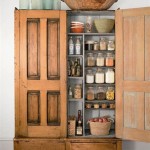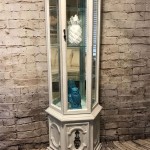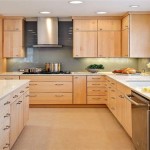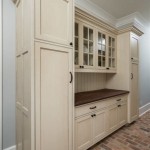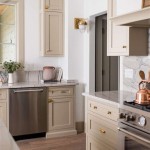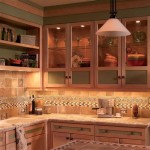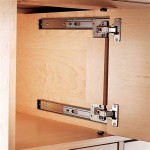Can I Paint Over Already Painted Cabinets On Wooden Floors?
Repainting kitchen cabinets is a popular and cost-effective way to refresh a kitchen's aesthetic. It can dramatically alter the overall look and feel of the space without undergoing a full-scale renovation. However, the success of repainting already painted cabinets is heavily reliant on proper preparation, the right materials, and careful execution, particularly when there are wooden floors nearby that need to be protected. Numerous factors influence the feasibility and longevity of the paint job. This article will explore the key considerations and processes involved in painting over already painted cabinets in a kitchen with wooden floors.
Before embarking on this project, a thorough assessment of the existing cabinet finish and the condition of the wooden floors is crucial. Understanding what type of paint was previously used on the cabinets will dictate the necessary preparation steps. Oil-based paints generally require more extensive sanding and priming compared to latex-based paints. The condition of the wooden floors is equally important. Are they sealed properly? Are there any gaps or cracks that paint could seep into? Identifying these issues beforehand will save time and frustration later in the process.
Surface Preparation is Paramount
Proper surface preparation is the most critical step in ensuring a durable and aesthetically pleasing paint finish. Without adequate preparation, the new paint may not adhere properly, leading to chipping, peeling, and an overall unsatisfactory result. This starts with a thorough cleaning to remove grease, dirt, and any other contaminants that may prevent the paint from bonding to the surface. A degreasing cleaner specifically designed for kitchen cabinets is highly recommended. Alternatively, a mixture of warm water and dish soap can be used, followed by a clean water rinse.
After cleaning, assess the existing paint for any imperfections such as chips, cracks, or peeling areas. These imperfections must be addressed before applying a new coat of paint. Use a scraper or putty knife to remove any loose paint. Fill any holes or cracks with wood filler and allow it to dry completely. Once dry, sand the filled areas smooth, ensuring a seamless transition between the filler and the surrounding surface.
Sanding the existing cabinet finish is essential for creating a slightly rough surface that will allow the new paint to adhere properly. Use a medium-grit sandpaper (around 120-180 grit) to lightly sand the entire surface of the cabinets. Focus on removing any gloss from the existing paint. After sanding, wipe down the cabinets with a tack cloth to remove any sanding dust. This step is crucial for preventing dust particles from becoming embedded in the new paint finish.
Priming is another crucial step, especially when painting over dark-colored cabinets or when switching from an oil-based to a latex-based paint. A high-quality primer will create a uniform surface for the new paint to adhere to, preventing bleed-through from the old paint and ensuring a consistent color. Choose a primer that is compatible with both the existing paint and the new paint. Apply the primer in thin, even coats, following the manufacturer's instructions for drying time. Sand the primer lightly with fine-grit sandpaper (around 220 grit) after it has dried completely to create an even smoother surface for painting.
Protecting the Wooden Floors
Protecting the wooden floors from paint spills and splatters is vital to avoid permanent damage or staining. Preventing paint from reaching the floor in the first place is far more efficient than attempting to clean up spills after they occur. The best approach is to use a combination of protective materials to provide comprehensive coverage.
Drop cloths are a fundamental tool for floor protection. Canvas drop cloths are a durable and reusable option, offering excellent protection against paint spills. Plastic drop cloths are less expensive but can be slippery and more prone to tearing. Consider using a combination of both, placing plastic drop cloths underneath canvas drop cloths for added protection. Ensure the drop cloths are large enough to extend beyond the work area, covering any potential spill zones.
Painter's tape is essential for creating crisp, clean lines and preventing paint from bleeding onto adjacent surfaces, such as baseboards or the bottom edges of cabinets that meet the floor. Use a high-quality painter's tape that is designed for delicate surfaces, such as wood. Apply the tape carefully, ensuring a tight seal along the edges. Press the tape firmly with a putty knife or a similar tool to prevent paint from seeping underneath.
In addition to drop cloths and painter's tape, consider using cardboard or construction paper to protect specific areas of the floor. For example, placing cardboard under the cabinets while sanding or painting will provide an extra layer of protection against dust and drips. These materials can also be used to protect areas that are difficult to cover with drop cloths, such as corners or tight spaces.
Be vigilant throughout the painting process, regularly checking the drop cloths for any spills or leaks. Wipe up any spills immediately with a damp cloth. Replace or reposition the drop cloths as needed to ensure adequate coverage. Taking these precautions will minimize the risk of damage to the wooden floors and save time and effort in the long run.
Selecting the Right Paint and Application Techniques
Choosing the right paint is crucial for achieving a durable and attractive finish on kitchen cabinets. Consider the durability, sheen, and application properties of different paint types before making a decision. Acrylic latex paints are a popular choice for kitchen cabinets due to their durability, ease of application, and low odor. They are also water-based, making them easy to clean up. Alkyd paints, also known as oil-based paints, offer excellent durability and a smooth, hard finish. However, they have a stronger odor and require mineral spirits for cleanup.
The sheen of the paint will affect the overall look of the cabinets and their ease of cleaning. Semi-gloss and gloss finishes are durable and easy to clean, making them a good choice for high-traffic areas like the kitchen. However, they can also highlight imperfections in the surface. Satin and eggshell finishes offer a softer look and are more forgiving of imperfections, but they may be slightly less durable and harder to clean. Consider the overall style of the kitchen and the desired aesthetic when selecting the paint sheen.
Proper application techniques are essential for achieving a smooth, even finish. Use a combination of brushes and rollers to apply the paint. A high-quality brush is ideal for painting detailed areas, such as edges and corners. Use a small foam roller for painting larger, flat surfaces. Apply the paint in thin, even coats, avoiding drips and runs. Allow each coat to dry completely before applying the next coat. Lightly sand between coats with fine-grit sandpaper (around 220 grit) to create a smooth surface. Apply two to three coats of paint for optimal coverage and durability.
Consider using a paint sprayer for a professional-looking finish. Paint sprayers can provide a smooth, even coat of paint with minimal brushstrokes. However, they require careful setup and cleanup, and it is essential to practice proper spraying techniques to avoid runs and drips. If using a paint sprayer, be sure to mask off the surrounding areas thoroughly to protect them from overspray.
Following these guidelines will contribute to a successful cabinet repainting project, ensuring a beautiful and durable finish while protecting wooden floors from damage.

Best Practices For Painting Over Painted Cabinets The Morris Mansion

Questionnaire Is It Better To Paint Or Restain Wood Cabinets

Painted Wood Cabinets Will They Last

Painted Wood Kitchen Cabinets Before After Photos

Putty Colored Cabinets And Cabinet Painting Tips The Lilypad Cottage

How To Paint Laminate Cabinets Without Sanding The Palette Muse

Questionnaire Is It Better To Paint Or Restain Wood Cabinets

The Best Way To Paint Kitchen Cabinets No Sanding Palette Muse

Bayview Bungalow Diy Pattern Painted Wood Floors I

How To Paint Over Old Painted Cabinets Easy Guide My Favorite Painters
Related Posts

